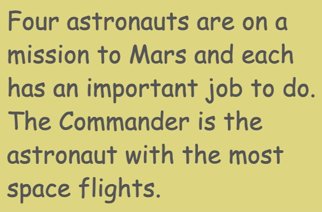Another opportunity to put maths in context - celebrate the launch of the Hubble Space Telescope on 24th April. To start you off, here is a logic problem set in a space context for Y4-5. It is easy for children to give up when they get stuck on a problem and knowing when and how to prompt groups or individuals when they are stuck is an important teaching skill. I’ve included some question prompts for the mystery to help with this.
Can you use trial and error – what if…?
Give them cards with the following on:
‘What if _______ was the pilot?’
‘What if _____ flights is the highest number of flights?’
Answer:
Brad is the commander and has been on 12 flights.
Matt is the Navigator and has been on 7 flights.
Dan is the Engineer and has been on 9 flights.
Luke is the Pilot and has been on 4 flights.
Give them cards with the following on:
‘What if _______ was the pilot?’
‘What if _____ flights is the highest number of flights?’
Answer:
Brad is the commander and has been on 12 flights.
Matt is the Navigator and has been on 7 flights.
Dan is the Engineer and has been on 9 flights.
Luke is the Pilot and has been on 4 flights.
This game is from a pack of Mystery Worlds.
There is a set for each year Y3, Y4, Y5, Y6 with 12 main mysteries - one for each half term.
There is a set for each year Y3, Y4, Y5, Y6 with 12 main mysteries - one for each half term.
Related articles
How many ways can a star be drawn?
Using 2D shapes to draw stars - activities for KS1 and KS2
Broadbent Maths Planning Menu - User school resources
Make a star
Accurate measuring and a recap on properties of shapes
How many ways can a star be drawn?
Using 2D shapes to draw stars - activities for KS1 and KS2
Broadbent Maths Planning Menu - User school resources
Make a star
Accurate measuring and a recap on properties of shapes
Useful websites
The Hubble telescope has its own hubblesite, it has an education page (I've not looked at this in detail but it might be worth a look) and a gallery of great free-to-use images which are amazing.
NASA has royalty-free resources - lots of lovely images with an education page.
The Hubble telescope has its own hubblesite, it has an education page (I've not looked at this in detail but it might be worth a look) and a gallery of great free-to-use images which are amazing.
NASA has royalty-free resources - lots of lovely images with an education page.



